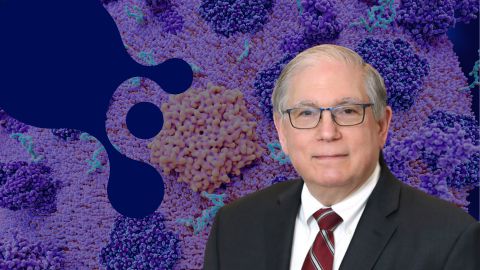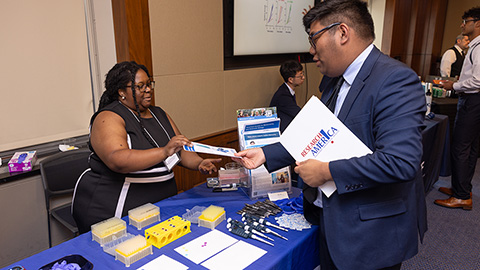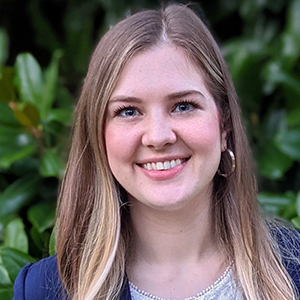ASBMB meets with federal science agencies
The American Society for Biochemistry and Molecular Biology held a series of meetings earlier this month with officials at the National Institutes of Health, National Science Foundation and Department of Energy.
The Public Affairs Advisory Committee and staff members convened the 10 meetings the week of June 6 to advocate for policy changes that will benefit the biomedical research enterprise and to learn about new or updated science-funding programs that will benefit ASBMB members.
Ann West is a PAAC member and the associate vice president of research development and a professor at the University of Oklahoma. She said she thought the meetings with NIH were mutually beneficial.
“We were able to provide input from the ASBMB constituents about the grant-review process and were pleased to learn of the NIH efforts, for example, regarding bias training and the recruitment of diverse sets of reviewers,” West said. “In addition, we advocated for continued support of programs for next-generation scientists and were able to provide some insight to the agency program directors. This can be an effective way to have our collective voice heard.”
NIH to resume in-person peer review panels
The NIH Center for Scientific Review will resume in-person peer-review panels in the fall, pending no significant change to COVID-19 infection rates.
CSR will phase in in-person meetings so that one of every three panels per year will be in person and the other two will be virtual.
Notably, data presented at the meeting demonstrated that virtual review panels score grants similarly to in-person review panels, but representatives at the CSR explained that reviewers have two significant complaints about virtual meetings: reduced discussion and loss of informal networking opportunities.
NIGMS doubling down on MIRA
Officials at the National Institute for General Medical Sciences said they’re focused on the future of the Maximizing Investigators' Research Award program. In short, MIRA funds people, not projects. NIGMS designed the program to be flexible with regard to the science pursued and to fund each grantee for five years. In contrast, a traditional aims-driven R01 award lasts four years.
NIGMS officials said the agency plans to increase the portion of its principal investigators funded by MIRA to 65% from 40%. Last year, the first cohort of MIRA awardees had a renewal rate of 86%, which was nearly double the R01 renewal rate of only 45.3%. The NIGMS appears to be on its way to reaching its goal.
Investigators no longer must have prior R01s from NIGMS to be eligible for MIRA, and early- career investigators still can apply to MIRA without an R01.
Many ASBMB members have expressed support for MIRA, and the PAAC thanked the NIGMS for its leadership in providing a stabilizing funding mechanism for fundamental biomedical research.
NIA provides a wealth of opportunities
ASBMB members might consider applying their research questions to Alzheimer's disease and Alzheimer's disease–related dementias. The National Institute of Aging has multiple funding opportunities, and its funding pay lines (the rate of success for research grant applications) for AD/ADRD programs are as much as two or three times higher than those of most other NIH institutes.
Furthermore, graduate students in any field who are interested in neurological diseases can pursue the institute’s Transition to Aging Research for Predoctoral Students award. This F99/K00 award supports students through their dissertations and into postdoctoral positions focused on aging research.
DOE touts its facilities and resources
Add more power to your experiments without a big price tag!
DOE officials emphasized that the agency has several user facilities with cutting-edge resources and instrumentation — including advanced supercomputers, particle accelerators, large X-ray light sources, neutron-scattering sources, specialized facilities for nanoscience and genomics, and others — that are available to scientists at no cost for nonproprietary research. They encouraged ASBMB members to apply for time on these instruments.
NCI programs: old and new
A long-standing effort by the National Cancer Institute has been to develop partnerships between institutions serving underserved groups, populations with health disparities and underrepresented students and NCI-designated Cancer Centers (CCs) via the Partnerships to Advance Cancer Health Equity program. Over the years, the program has facilitated these partnerships to combine expertise and better understand and reduce cancer health disparities that disproportionately affect racial and ethnic minority and socioeconomically disadvantaged populations. Today, NCI officials are leveraging what they have learned over the past two decades to improve the outreach and engagement performed by investigators at CCs.
Last year, the NCI began a new program to “support educational activities that enhance the diversity of the biomedical, behavioral and clinical research workforce.” The Youth Enjoy Science Research Education Program seeks to engage middle school, high school and/or undergraduate students from historically marginalized populations in cutting-edge cancer research experiences.
NCI is also dedicating significant resources to its F31 and F30 grants; in fiscal year 2021 alone, it funded 704 F awards totaling $30 million. NCI officials are evaluating the data they've collected on F awards thus far and will be releasing them soon to the public. While NCI receives numerous applications for F awards, officials said they intend to reach out to students at minority-serving institutions to ensure that they're aware of NCI funding opportunities, including F awards. Their aim is to set up students and scientists for success, regardless of their backgrounds.
NHLBI prioritizes long COVID studies
The National Heart, Lung, and Blood Institute has followed the lead of the NIGMS by offering its own R35 awards. The Outstanding Investigator Award and Emerging Investigator Award Program came to be in 2019. Both the NIGMS and NHLBI R35s fund overall research programs rather than narrowly focused research projects, but the NHLBI R35 provides funding for seven years, as opposed to NIGMS’s five-year award.
Officials at NHLBI said they are prioritizing research on long-COVID disease at this time. NHLBI is especially focused on community-engaged research related to COVID-19 and using that approach to overcome misinformation.
Funding and resources for students and postdocs
One priority of the ASBMB is to support the next generation of scientists. The federal agencies and institutes offer a variety of programs that fund bright trainees across the nation.
Officials at the NIA were enthusiastic about sharing information about their programs. To assist postdoctoral fellows interested in applying for NIA’s most popular career-development award, the K99/R00 Pathway to Independence Award, the institute recently released two sample applications detailing the complex, lengthy and multiple required documents. The NIA was the first institute to provide these materials, and the ASBMB hopes to see other institutes follow suit.
The NIA also offers a Career Transition Award (K22) for postdoctoral fellows. It funds three years of research at an extramural institution as tenure-track, full-time assistant professor.
Officials at the National Institute on Drug Abuse said they are eager to support graduate and postdoc students in a variety of ways, including funding more graduate student projects through its F award programs. The institute offers the three main predoctoral F awards — F30, F31 and F31-Diversity — which support M.D./Ph.D. fellows, predoctoral fellows, and predoctoral fellows from historically marginalized groups, respectively. The NIDA is also expanding its mentoring programs, such as the National Diversity Scholars Network, and hosting grant-writing workshops for postdocs and early-career scientists.
NIDA also participates in the ENDURE Undergraduate Education Program, which provides training for undergrads, particularly those from backgrounds underrepresented in science, in neuroscience research.
Other types of support for next-gen researchers
Meanwhile, the NIAID’s Primary Caregiver Technical Assistance Supplements fund postdocs who need to take time away from the bench for health reasons or to serve as primary caregivers. These funds pay a technician to maintain high productivity while the NIAID fellow is away, minimizing setbacks to their projects. The ASBMB hopes to see other institutes and agencies offer similar opportunities to retain research talent who face varied personal situations. Trainees too often are forced to take formal leave of absences, lose benefits, or step away from academia altogether.
PAAC members and ASBMB staff inquired about the availability and uptake of re-entry supplements to recapture talented scientists who have stepped away from academia for either personal or professional reasons (especially during the COVID-19 pandemic). They learned that while most institutes have a re-entry supplement, eligibility and policies vary. These supplements need to be equitable across all NIH institutes, so the ASBMB team will conduct further research and advocate for re-entry supplements that serve a broader group of scientists with unique personal and professional barriers.
Finally, the PAAC spoke with several NIH institutes about removing administrative burdens related to the Ruth L. Kirschstein Institutional National Research Service Award (T32) programs. The ASBMB described its position on this matter and made several recommendations in this position statement, and officials at the NIH Office of Extramural Research are taking these points for discussion in future meetings.
Diversity, equity, accessibility and inclusion in STEM
The ASBMB delegation asked agencies and institutes about efforts to broaden and/or support the participation of historically marginalized populations in research, as well as to reach students and investigators at minority-serving institutions.
The NIH Center for Scientific Review is incorporating diversity, equity accessibility and inclusion into study sections and policies. It recently launched a bias awareness training for peer reviewers that it plans to make mandatory for all reviewers, chairs and scientific review officers.
The CSR is also pursuing a broad cultural change to shift the set of reviewers away from senior and well-established investigators and toward peer reviewers from diverse backgrounds and institutions. However, the limited number of faculty members from historically marginalized populations in certain scientific disciplines, including biochemistry and molecular biology, impedes these efforts.
Officials at the National Institute for Child Health and Human Development talked about a partnership with Howard University that offers undergraduates paid internships at the institute. They said they are looking into replicating this program with other MSIs. They also expressed strong support for the Society for Developmental Biology’s Choose Development! program. It offers undergraduates from historical marginalized populations an opportunity to participate in two consecutive summer lab internships to introduce them to the field. They suggested that the ASBMB consider developing a similarly structured program.
At the NSF, officials said they are seeking to develop a virtual grants office to help under-resourced institutions become more competitive for grant funding. This is part of its larger effort to reach out to under-resourced institutions looking to expand their undergraduate and graduate research programs.
Shantá Hinton, a member of the PAAC and an associate professor at William & Mary in Virginia, said NSF leaders reassured her of their commitments to basic science. “NSF remains interested in funding basic research and has not lost understanding that such research is foundational for the success of other ‘trendy’ research programs,” she said.
Hinton added: “These meetings provide the opportunity for the ASBMB PAAC to function as a unit, representing various types of institutions, such as community colleges, undergraduate teaching or research institutions, and research-intensive institutions. The input of such a diverse group provides insight for agencies such as NSF to better serve the scientific community.”
The DOE requested support from Congress recently for a new “Funding for Accelerated, Inclusive Research” initiative next year, which would enhance research on clean energy, climate and related topics at MSIs by building beneficial relationships with DOE national laboratories. And the agency’s Reaching a New Energy Sciences Workforce program offers hands-on experiences for students, postdocs and faculty at a DOE national laboratory.
Himadri Pakrasi, a PAAC member and a professor at Washington University, said he found the meetings with representatives of the DOE Basic Energy Sciences program and the NSF Directorate for Biological Sciences to be very useful.
“I particularly liked the willingness of both agency staff members to share information about their new initiatives with us as well as with all members of ASBMB,” he said, “Both agency staff members were also willing to hold information sessions during our annual meetings.”
‘Everyone wants to help’
Rick Page leads the PAAC and is a professor at Miami University in Ohio. Page led a majority of the discussions with federal agency leaders, which he described as “friendly, frank, and productive.”
“Federal agency visits forge connections with funders that allow us to advance the interests and priorities of ASBMB members while simultaneously cultivating a relationship that lets us more effectively advocate for the agencies,” he said.
Most importantly, he said “the pervading sense in every meeting is that everyone wants to help and to do what they can to support investigators in advancing science and the agency mission."
The PAAC and policy team will continue to follow up on these conversations, push for improvements at the federal science agencies that fund ASBMB members, and keep members apprised of new funding opportunities.
Sign up for the ASBMB advocacy newsletter or read the archive.
DEAI-related programs
Undergraduates
- ENDURE Undergraduate Education Program is available at several NIH institutes.
- Choose Development! is run by the Society for Developmental Biology.
- Undergraduate Scholarship Program facilitates research opportunities at the NIH main campus.
- NRSA Individual Predoctoral Fellowships to Promote Diversity in Health-Related Research (F31) awards are issued NIH-wide. NCI officials emphasized their sustained and frequent support of this award.
- Aging Research Dissertation Awards to Increase Diversity is offered by the NIA
- IRACDA Programs, funded by the NIGMS, are perfect programs to apply for a postdoctoral fellowship to gain teaching experience and a cohort of peers.
- The National Diversity Scholars Network is a cohort mentorship program at the NIDA.
- Maximizing Opportunities for Scientific and Academic Independent Careers is funded by NIGMS. (Learn about ASBMB’s MOSAIC participation.)
- This resource from Stanford University links to NIH’s various diversity K awards.
- Butler–Williams Scholars Program at the NIA is for researchers new to the field of aging.
- Launching Early-Career Academic Pathways in the Mathematical and Physical Sciences at the NSF is for junior faculty at “institutions that do not traditionally receive significant amounts of NSF–MPS funding.”
- The National Diversity Scholars Network is a cohort mentorship program at the NIDA.
- Diversity R01 for New and "At-Risk" Investigators is a research grant offered by NIDA, National Institute of Neurological Disorders and Stroke and the National Institute of Mental Health.
Enjoy reading ASBMB Today?
Become a member to receive the print edition four times a year and the digital edition monthly.
Learn moreGet the latest from ASBMB Today
Enter your email address, and we’ll send you a weekly email with recent articles, interviews and more.
Latest in Policy
Policy highlights or most popular articles

Embrace your neurodivergence and flourish in college
This guide offers practical advice on setting yourself up for success — learn how to leverage campus resources, work with professors and embrace your strengths.

ASBMB honors Lawrence Tabak with public service award
He will deliver prerecorded remarks at the 2025 ASBMB Annual Meeting in Chicago.

Summer internships in an unpredictable funding environment
With the National Institutes of Health and other institutions canceling summer programs, many students are left scrambling for alternatives. If your program has been canceled or delayed, consider applying for other opportunities or taking a course.

Black excellence in biotech: Shaping the future of an industry
This Black History Month, we highlight the impact of DEI initiatives, trailblazing scientists and industry leaders working to create a more inclusive and scientific community. Discover how you can be part of the movement.

ASBMB releases statement on sustaining U.S. scientific leadership
The society encourages the executive and legislative branches of the U.S. government to continue their support of the nation’s leadership in science.

ASBMB and advocacy: What we accomplished in 2024
PAAC members met with policymakers to advocate for basic scientific research, connected some fellow members with funding opportunities and trained others to advocate for science.

